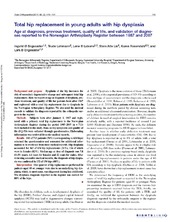| dc.contributor.author | Engesæter, Ingvild Øvstebø | en_US |
| dc.contributor.author | Lehmann, Trude | en_US |
| dc.contributor.author | Laborie, Lene Bjerke | en_US |
| dc.contributor.author | Lie, Stein Atle | en_US |
| dc.contributor.author | Rosendahl, Karen | en_US |
| dc.contributor.author | Engesæter, Lars B. | en_US |
| dc.date.accessioned | 2014-01-22T10:07:08Z | |
| dc.date.available | 2014-01-22T10:07:08Z | |
| dc.date.issued | 2011-04 | eng |
| dc.identifier.issn | 1745-3674 | |
| dc.identifier.issn | 1745-3682 | |
| dc.identifier.uri | https://hdl.handle.net/1956/7692 | |
| dc.description.abstract | Background and purpose: Dysplasia of the hip increases the risk of secondary degenerative change and subsequent total hip replacement. Here we report on age at diagnosis of dysplasia, previous treatment, and quality of life for patients born after 1967 and registered with a total hip replacement due to dysplasia in the Norwegian Arthroplasty Register. We also used the medical records to validate the diagnosis reported by the orthopedic surgeon to the register. Methods: Subjects born after January 1, 1967 and registered with a primary total hip replacement in the Norwegian Arthroplasty Register during the period 1987–2007 (n = 713) were included in the study. Data on hip symptoms and quality of life (EQ-5D) were collected through questionnaires. Elaborating information was retrieved from the medical records. Results: 540 of 713 patients (76%) (corresponding to 634 hips) returned the questionnaires and consented for additional information to be retrieved from their medical records. Hip dysplasia accounted for 163 of 634 hip replacements (26%), 134 of which were in females (82%). Median age at time of diagnosis was 7.8 (0–39) years: 4.4 years for females and 22 years for males. After reviewing accessible medical records, the diagnosis of hip dysplasia was confirmed in 132 of 150 hips (88%). Interpretation: One quarter of hip replacements performed in patients aged 40 or younger were due to an underlying hip dysplasia, which, in most cases, was diagnosed during late childhood. The dysplasia diagnosis reported to the register was correct for 88% of the hips. | en_US |
| dc.language.iso | eng | eng |
| dc.publisher | Informa Healthcare | eng |
| dc.relation.ispartof | <a href="http://hdl.handle.net/1956/7693" target="blank">Hip dysplasia in young adults</a> | eng |
| dc.rights | Attribution-NonCommercial CC BY-NC | eng |
| dc.rights.uri | http://creativecommons.org/licenses/by-nc/3.0/ | eng |
| dc.title | Total hip replacement in young adults with hip dysplasia. Age at diagnosis, previous treatment, quality of life, and validation of diagnoses reported to the Norwegian Arthroplasty Register between 1987 and 2007 | en_US |
| dc.type | Peer reviewed | |
| dc.type | Journal article | |
| dc.description.version | publishedVersion | en_US |
| dc.rights.holder | Copyright 2011 Informa Healthcare | |
| dc.identifier.doi | https://doi.org/10.3109/17453674.2011.566146 | |
| dc.identifier.cristin | 842836 | |
| dc.source.journal | Acta Orthopaedica | |
| dc.source.40 | 82 | |
| dc.source.14 | 2 | |
| dc.source.pagenumber | 149-154 | |
| dc.identifier.citation | Acta Orthopaedica 82(2): 149–154 | |

